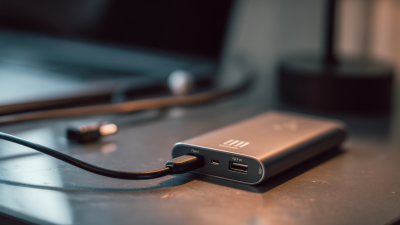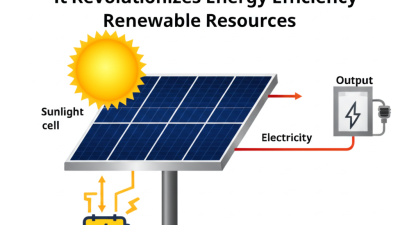Exploring the Future: How Ion Battery Lithium Technology Powers Sustainable Energy Solutions
Table of Contents
- The Rise of Ion Battery Lithium Technology in Sustainable Energy Solutions
- Key Innovations Driving the Future of Ion Battery Efficiency
- Integrating Ion Battery Solutions with Renewable Energy Systems
- Environmental Impact: How Lithium Technology Supports Sustainability
- Challenges and Opportunities in the Ion Battery Market for Clean Energy
- FAQS
- Conclusion
- Related Posts
As the world pivots towards sustainable energy solutions, the significance of Ion Battery Lithium technology has never been more pronounced. According to a recent report by the International Energy Agency (IEA), the global lithium-ion battery market is projected to grow from $44 billion in 2020 to over $100 billion by 2025, reflecting an annual growth rate of approximately 18%. This surge is driven by the escalating demand for energy storage systems across various sectors, including household energy storage and electric mobility.

Roofer Electronics Technology (Shanwei) Co., Ltd., with its 27 years of expertise in R&D, manufacturing, and solution services for lithium batteries, is at the forefront of this energy revolution. By providing high-quality battery products for applications ranging from power tools to electric bicycles, Roofer demonstrates its commitment to advancing sustainable energy technologies that meet the evolving needs of consumers and industries alike.
The Rise of Ion Battery Lithium Technology in Sustainable Energy Solutions
The rise of ion battery lithium technology is transforming the landscape of sustainable energy solutions. As the world moves towards greener alternatives, the demand for efficient storage systems has surged. According to a recent report from MarketsandMarkets, the global lithium-ion battery market is projected to grow from $44.2 billion in 2020 to $94.4 billion by 2025, reflecting a compound annual growth rate (CAGR) of 16.3%. This growth is primarily driven by the increasing adoption of electric vehicles (EVs) and renewable energy sources such as solar and wind power.
Ion battery lithium technology offers significant advantages in terms of energy density and longevity compared to traditional battery systems. A report by McKinsey indicates that lithium-ion batteries can yield more than four times the energy per kilogram than lead-acid batteries, which is crucial for applications requiring high energy output with minimal weight. Furthermore, advancements in battery recycling processes and material recovery are enhancing the sustainability credentials of lithium batteries. The International Energy Agency (IEA) projects that by 2030, the share of lithium batteries in global battery production could exceed 50%, marking a significant step toward a more sustainable energy ecosystem.
Key Innovations Driving the Future of Ion Battery Efficiency
The future of ion battery efficiency is being shaped by groundbreaking innovations that address both performance and sustainability. Recent advancements in material science, such as the development of silicon anodes, are significantly enhancing battery capabilities. These materials not only facilitate faster charging times but also extend the overall cycle life of batteries, making them more reliable for various applications, including electric vehicles and renewable energy storage systems.
Additionally, the emergence of new technologies has transformed battery design, resulting in more efficient separators that improve the safety and performance of lithium-ion batteries. The push toward recycling lithium batteries is also crucial, as it reduces environmental impact while conserving vital materials for future production. By integrating these innovations, the energy storage sector is poised to meet the increasing demand for sustainable solutions, reflecting a commitment to both technological progress and ecological responsibility.
Integrating Ion Battery Solutions with Renewable Energy Systems
The integration of ion battery solutions, particularly lithium and sodium-ion technologies, plays a pivotal role in enhancing renewable energy systems. The recent launch of the world’s first grid-forming sodium-ion battery storage plant in China exemplifies this synergy, as it combines both technologies to stabilize renewable energy output. This development addresses the inherent intermittency of sources like wind power, which require effective energy management and storage for a reliable power supply. By leveraging the strengths of both lithium and sodium-ion batteries, energy systems can achieve greater efficiency and resilience.
Moreover, advancements in energy storage technologies are vital for supporting the growing demand for sustainable energy solutions. With projects emerging worldwide that focus on integrated systems, such as solar photovoltaic coupled with sodium-ion batteries, the energy landscape is poised for transformation. As regions like Southeast Asia adopt these innovative approaches, the capacity for renewable energy integration will expand, driving down costs and increasing accessibility. The shift towards diverse battery solutions not only enhances performance but also contributes significantly to the global initiative for a carbon-neutral future.
Environmental Impact: How Lithium Technology Supports Sustainability
Lithium technology plays a crucial role in advancing sustainable energy solutions, particularly through the development of ion battery technology. As the demand for clean energy sources increases, lithium-ion batteries are becoming indispensable due to their high energy density and longevity. These batteries enable the effective storage of renewable energy generated from solar panels and wind turbines, providing a reliable energy supply even when sun or wind conditions are not optimal. This capability significantly reduces dependence on fossil fuels, which are major contributors to environmental degradation and climate change.
Moreover, the environmental impact of lithium technology extends beyond energy storage. Innovations in lithium extraction and recycling processes are being implemented to minimize ecological disruption and reduce waste. Companies are now focusing on sustainable practices, such as sourcing lithium from brine rather than hard rock, which can lessen environmental harm. Additionally, advancements in recycling technology ensure that lithium batteries can be processed effectively at the end of their life cycle, recovering valuable materials and reducing the need for new resources. This comprehensive approach to lithium technology not only promotes sustainability but also paves the way for a more environmentally friendly energy landscape.
Challenges and Opportunities in the Ion Battery Market for Clean Energy
The ion battery market, particularly those utilizing lithium technology, presents a unique blend of challenges and opportunities within the realm of clean energy. One significant challenge is the environmental impact of lithium extraction. Mining operations can disrupt local ecosystems, and the process often involves significant water usage and pollution. Addressing these ecological concerns is essential, as the sustainability of ion batteries hinges not just on their energy efficiency but on the overall environmental footprint from cradle to grave.
Conversely, the transition towards cleaner energy sources has spurred innovation and investment in ion battery technologies. As governments and industries prioritize decarbonization, there is an increasing demand for efficient energy storage solutions. This demand presents opportunities for the development of advanced battery recycling processes and alternatives to traditional lithium sources, such as lithium-ion batteries built from more sustainable materials. Overall, while the ion battery sector faces obstacles, the potential for growth and the contribution to sustainable energy infrastructures remain significant.
Exploring the Future: How Ion Battery Lithium Technology Powers Sustainable Energy Solutions - Challenges and Opportunities in the Ion Battery Market for Clean Energy
| Parameter | Current Status | Future Outlook | Challenges | Opportunities |
|---|---|---|---|---|
| Battery Energy Density | 250 Wh/kg | 400 Wh/kg projected by 2030 | Material scarcity | Innovative recycling methods |
| Cycle Life | 500-1500 cycles | 2000 cycles anticipated | Degradation over time | Emergence of solid-state batteries |
| Charging Time | 1-2 hours | 15-30 minutes targeted | Infrastructure limitations | Fast-charging technology advancements |
| Cost per kWh | $150 | Projected to drop to $60 | High manufacturing costs | Economies of scale |
| Environmental Impact | Moderate | Minimal with recycling | Land extraction issues | Green mining initiatives |
FAQS
: The lithium-ion battery market is primarily driven by the increasing adoption of electric vehicles (EVs) and renewable energy sources like solar and wind power, with projections indicating a rise from $44.2 billion in 2020 to $94.4 billion by 2025.
Ion battery lithium technology offers significant advantages in energy density and longevity, yielding over four times the energy per kilogram than lead-acid batteries, making it ideal for applications requiring high energy output with minimal weight.
Innovations such as the development of silicon anodes, improved battery designs with efficient separators, and advancements in battery recycling processes are significantly enhancing the performance and sustainability of ion batteries.
One major challenge is the environmental impact of lithium extraction, which can disrupt local ecosystems and involves high water usage and pollution. Addressing these issues is critical for the sustainability of ion batteries.
The transition to cleaner energy sources is generating opportunities for innovation and investment in ion battery technologies, including advancements in battery recycling processes and the development of alternative sustainable materials.
The International Energy Agency (IEA) projects that by 2030, the share of lithium batteries in global battery production could exceed 50%.
Battery recycling reduces environmental impact and conserves essential materials for future production, enhancing the overall sustainability credentials of lithium batteries.
Governments and industries are prioritizing decarbonization, increasing the demand for efficient energy storage solutions, which spurs innovation and investment in ion battery technology.
Technological progress in ion batteries reflects a commitment to meeting the growing demand for sustainable energy solutions while addressing ecological responsibilities.
The sustainability of ion batteries depends not only on their energy efficiency but also on their environmental impact throughout their lifecycle, from raw material extraction to disposal.
Conclusion
The article "Exploring the Future: How Ion Battery Lithium Technology Powers Sustainable Energy Solutions" delves into the transformative role of Ion Battery Lithium technology in advancing sustainable energy. It highlights the rise of these batteries as pivotal to energy storage systems, showcasing key innovations that enhance their efficiency and adaptability. By integrating Ion Battery solutions with renewable energy systems, the article emphasizes how they can facilitate a cleaner energy future.
Moreover, it addresses the environmental benefits of Lithium technology, illustrating its support for sustainability initiatives while also discussing the challenges and opportunities present in the Ion Battery market. With over 27 years of expertise, Roofer Electronics Technology (Shanwei) Co., Ltd. plays a significant role in this landscape, providing cutting-edge lithium battery and energy storage solutions across various applications, including household energy storage and electric vehicles.
Related Posts
-

How to Choose the Right Lithium Battery for Your Specific Needs
-

Revolutionizing Clean Energy with Cutting Edge Energy Storage Systems and Their Impact on Grid Stability
-

How to Optimize the Performance of Your 51.2v Lifepo4 Battery
-

Leading Global Manufacturer: Explore the Best 3.2v 100ah Lifepo4 Battery Cells Available Today
-

What is a Solar Cell Generator and How It Revolutionizes Energy Efficiency in Renewable Resources
-

Future Innovations in Best Solar Generating Stations for 2025 a Comprehensive Guide to Next Generation Technologies





 business@roofer.cn
business@roofer.cn +86 13502883088
+86 13502883088






